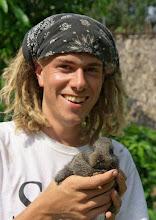 |
| Chamaeleo senegalensis |
I, too, find the idea of land conservation attractive. But I've also come to recognise that it is only a half good, a partial solution. In order to create "nature preserves" we must define that nature as excluding humanity. And by deeming man and his impact as unnatural, and all else as natural, we do both man and earth a great disservice: we exclude man from participating meaningfully in the story of life.
Of course, our interactions with this story are inevitable. We can not escape the fact that we are fully dependent on this earth for our food, clothing, water, warmth, and all of the resources that we use to construct our habitations, our tools, and our entertainment systems. And as long as that is all that defines the relationship, our environmentalist subculture are heroes for minimising this interaction. As long as we are basically consumers who treat the rest of the world like our proverbial pantry, our interaction with the the rest of Creation will be a primarily negative one, and limiting this interaction becomes a noble goal.
I've seen few signs of this attitude toward natural resources changing. If you are reading this, you have probably been encouraged your whole life to consume in ways that are less damaging to the environment, but probably rarely encouraged to interact with it in meaningful ways. Think about it: in the west, "interacting with nature" usually means hiking along a trail and looking at nature. The fact that you're probably trying to figure out what interacting with nature even looks like betrays the fact that we, as a culture, have greatly distanced ourselves from actual relationships with it.
 |
| "Wow! Look at all this nature!" |
Here in Senegal, like in much of the developing world, relationships with nature are still more intact than they usually are in the west. While many farmers are giving up farming and moving to the city, others still trim trees to feed their cows, who poop on the fields, which produce next year's millet crop. Yet even this relationship can become consumeristic. If a farmer only cuts down trees, harvests grasses, and extracts other resources, without also tending the forests, the grasslands, and the soil, he's treating it only as a pantry. It's not a relationship - it's a dependency. And most Senegalese have much more reason to be tempted into this type of relationship than you or I do. Often, harvesting those resources as fast as he can is the only way a Senegalese farmer sees to keep his children from starving to death.[1]
[2] Here in Senegal, however, we can't.[3] And that, ironically, might be our saving grace. For it forces us to restore our relationships with the land, rather than just avoiding them all together.[4][5] This will probably be a painful and difficult process, but in the end, I see hope for healthier community-land relationships than are possible through building fences alone.
This photo is of a fence protecting a plot of land from Africa's most efficient natural resource extractor - the domestic goat.
Part 2 will be about that land on the other side of the fence.
--
[1] - Certainly, this is an oversimplification. Often resources are also extracted for profit or prestige. But the fight for survival is real for many of Senegal's rural dwellers.
[2] - There once were, but this was no longer the case by the time we designated it a park. Now, there are still people making their living off of Yosemite National Park (I'm related to several of you), but this living is not based on resource extraction or exchange.
[3] - There are plenty of natural reserves in the developing world, including right here in Senegal: most for ecotourism purposes or (I suspect) because of international pressure. But any scrap of land that isn't fenced and guarded is used by someone for something. There is very little "unutilised" land like we see in the western US.
[4] - Actually, it forces us into a situation where doing so is most beneficial. Results still depend on desire and effort.
[5] - Incidentally, financial poverty has the same effect on human-human relationships. Money buys independence, which allows you to avoid difficult relationships. If you don't get along with your family, you can buy a bigger house, or better yet, move away from them. Being poor takes away those choices, and thereby supplies ample opportunity to work out those relationships instead of avoiding them. However, being forced to live in close proximity with people doesn't automatically mean you'll learn to get along with them. This is very visible here in Senegal, too: many women live in continuous strife with their abusive husbands or fathers-in-law, or the contentious other wives of their husband (Muslims are allowed up to four).






